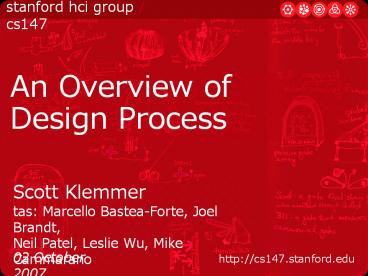CS376 Introduction - PowerPoint PPT Presentation
Title:
CS376 Introduction
Description:
Title: CS376 Introduction Author: Scott Klemmer Last modified by: Scott Klemmer Created Date: 6/23/2002 6:01:23 PM Document presentation format: On-screen Show (4:3) – PowerPoint PPT presentation
Number of Views:87
Avg rating:3.0/5.0
Title: CS376 Introduction
1
An Overview of Design Process
Scott Klemmertas Marcello Bastea-Forte, Joel
Brandt,Neil Patel, Leslie Wu, Mike Cammarano
02 October 2007
2
Learning Goals for Today
- Have an overview of the Interaction Design
process in general and the specific way it will
be applied in this course - Have a broad understanding of what Design means
for this course - Learn a first level of detail about the steps we
will be employing in the project - Understand how users can be involved in the
design process - See some examples of design projects
3
User Centered Design
- Users tasks and goals are the driving force
behind development - Users are consulted throughout development
- All design decisions are taken from within the
context of the users, their work, and their
environment
4
What is Design (Kelley)
- Not just problem solving Creative leap
- Messy No right answer
- Takes a point of view or many
- Calls for vision and multiple minds
- Open attitude many solutions
- Learned from experience with reflection
- Requires a feel for the materials
- Starts with broadening, followed by narrowing
- Requires ongoing mindfulness
5
Design phases (IDEO)
- Understand
- Observe
- Visualize and Predict
- Evaluate and Refine
- Implement
6
Simple Iterative Model
- Modified from p. 186 in Interaction Design
7
Needs Analysis
NEEDS
DESIGN
IMPLEMENT
EVALUATE
8
Contextual Inquiry
- Users and stakeholders
- Context
- At the interviewees workplace
- Partnership
- Designer is apprentice to Interviewee
- Can be guided by interviewee
9
Contextual Interviews
- Interpretation and elicitation of needs
- Observations must be interpreted by observer and
interviewee - Focus
- Short
- Inquire about work behaviors
- Intention is to design a new system
- Focus on design goals
10
Capturing the Data
- Observers head
- Written notes
- Sketches and photos of the setting
- Audio (or even Video)
11
Idea Generation
NEEDS
DESIGN
IMPLEMENT
EVALUATE
12
Brainstorming
- Group vs. Individual Creativity
- More Ideas More Creative Better
- Limited Time
- Keep a Record
- Brainstorm in Section next week! Brainstorming
is not just a good idea but an inexhaustible
source of inspiration and fresh thinking (IDEO)
13
The Rules According to IDEO
- Be Visual.
- Defer judgment.
- Encourage Wild Ideas.
- Build on the Ideas of Others.
- Go for Quantity.
- One Conversation at a Time.
- Stay Focused on the Topic.
14
Exploring Design Ideas
NEEDS
DESIGN
IMPLEMENT
EVALUATE
15
Sketches
From a previous cs147 project
16
Storyboards
http//www.storyboards-east.com/sb_dismoi.htm
17
Storyboards
18
Storyboards
19
Flipbook
20
Flipbook
21
Flow Diagrams
From a previous cs147 project
22
Woah Nelly!
- Sketches, Storyboards, Flipbooks, Diagrams
- Whats the Difference?
- When to use them?
- Why to use them?
- Whos the audience?
- Deliverable Storyboard only
- But, try as many as you can
23
Prototyping
NEEDS
DESIGN
IMPLEMENT
EVALUATE
24
Using Prototypes
- Allows multiple parties to envision together
- Designers
- Users
- Engineering, marketing, planning,..
- Reflective conversation with the materials
- Focus for identifying alternatives and tradeoffs
25
Low-Fidelity Paper Prototype
NEEDS
DESIGN
IMPLEMENT
EVALUATE
26
Tools
- Paper, Cardboard, Transparencies
- Tape, Glue, Rubber Cement
- Pens, Pencils, Markers
- Scissors
- Plastic Tubes, Paper Cups, CD Coasters
- Anything that you can buy in an arts and crafts
store (and that a kindergartener would have fun
using).
27
Examples Low-Fidelity Prototype
28
Examples Low-Fidelity Prototype
http//www.mindspring.com/bryce_g/projects/lo_fi.
html
29
Examples Low-Fidelity Prototype
http//bmrc.berkeley.edu/courseware/cs160/fall99/p
rojects/t4/body/low-fi/
30
User Testing
NEEDS
DESIGN
IMPLEMENT
EVALUATE
31
Tools
- 3-4 group members
- Greeter/Facilitator
- Computer (not necessary for low-fi testing)
- 2 Observers/Note takers
- Prototype
- Users!!!!
32
User Testing
http//www.cs.waikato.ac.nz/usability/facilities.h
tml http//www.itl.nist.gov/iad/gallery.html
33
High Fidelity Interactive Prototype
NEEDS
DESIGN
IMPLEMENT
EVALUATE
34
Tools
- HTML Javascript
- Java JFC/Swing
- Visual C, Visual Basic
- Flash MX, Director
- Mac Interface Builder
- othersor a mix of the above!!!
35
Examples Interactive Prototype
From cs160 at UC Berkeley
36
Examples Interactive Prototype
From cs247a at Stanford University
37
Examples Interactive Prototype
From cs160 at UC Berkeley
38
Examples of Projects
- Visual Voicemail
- Interactive Academic Planner
- Suzie Q
- ToneDeaf Revolution































